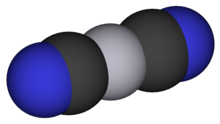
Back سيانيد الزئبق الثنائي Arabic سیانید جیوه (II) AZB Cianur de mercuri(I) Catalan Quecksilber(II)-cyanid German سیانید جیوه (II) Persian Elohopeasyanidi Finnish Cyanure de mercure(II) French Higany(II)-cianid Hungarian Cianuro mercurico Italian シアン化水銀(II) Japanese
 | |
| Names | |
|---|---|
| IUPAC name
dicyanomercury
| |
| Other names
mercuric cyanide; cyanomercury; neutral mercury cyanide (1:2); mercury dicyanide; hydrargyri cyanidum[1] (homeopathy)
| |
| Identifiers | |
3D model (JSmol)
|
|
| 3679510 | |
| ChEBI | |
| ChemSpider | |
| ECHA InfoCard | 100.008.857 |
| EC Number |
|
| 2563 | |
PubChem CID
|
|
| UNII | |
| UN number | 1636 |
CompTox Dashboard (EPA)
|
|
| |
| |
| Properties | |
| Hg(CN)2 | |
| Molar mass | 252.63 g/mol |
| Appearance | colorless crystals or white powder |
| Odor | odorless |
| Density | 3.996 g/cm3 |
| Melting point | 320 °C (608 °F; 593 K)[3] (decomposes) |
| 9.3 g/100 mL (14 °C) 53.9 g/100 mL (100 °C)[2] | |
| Solubility | 25 g/100 mL (methanol, 19.5 °C) soluble in ethanol, ammonia, glycerin slightly soluble in ether insoluble in benzene |
| −67.0·10−6 cm3/mol | |
Refractive index (nD)
|
1.645 |
| Hazards | |
| Occupational safety and health (OHS/OSH): | |
Main hazards
|
Highly toxic |
| GHS labelling:[4] | |
  
| |
| Danger | |
| H300, H301, H310, H330, H373, H410 | |
| P260, P262, P264, P270, P271, P273, P280, P284, P301+P310, P302+P350, P304+P340, P310, P314, P320, P322, P330, P361, P363, P391, P403+P233, P405, P501 | |
| NFPA 704 (fire diamond) | |
| Lethal dose or concentration (LD, LC): | |
LD50 (median dose)
|
26 mg/kg |
Except where otherwise noted, data are given for materials in their standard state (at 25 °C [77 °F], 100 kPa).
| |
Mercury(II) cyanide, also known as mercuric cyanide, is a poisonous compound of mercury and cyanide. It is an odorless, toxic white powder. It is highly soluble in polar solvents such as water, alcohol, and ammonia, slightly soluble in ether, and insoluble in benzene and other hydrophobic solvents.[3]
- ^ "Hydrargyrum. Mercury. Part 5." http://chestofbooks.com/health/materia-medica-drugs/Manual-Pharmacology/Hydrargyrum-Mercury-Part-5.html (accessed April 1, 2009).
- ^ Cite error: The named reference
Aylettwas invoked but never defined (see the help page). - ^ a b Kocovsky, P., G. Wang, and V. Sharma. "Mercury(II) Cyanide." e-EROS Encyclopedia of Reagents for Organic Synthesis. Chichester, UK: John Wiley & Sons, Ltd., 2001. http://www.mrw.interscience.wiley.com/eros/articles/rm034/sect0-fs.html
- ^ "Mercuric cyanide". pubchem.ncbi.nlm.nih.gov. Retrieved 23 December 2021.
- ^ "MERCURIC CYANIDE | CAMEO Chemicals | NOAA".

